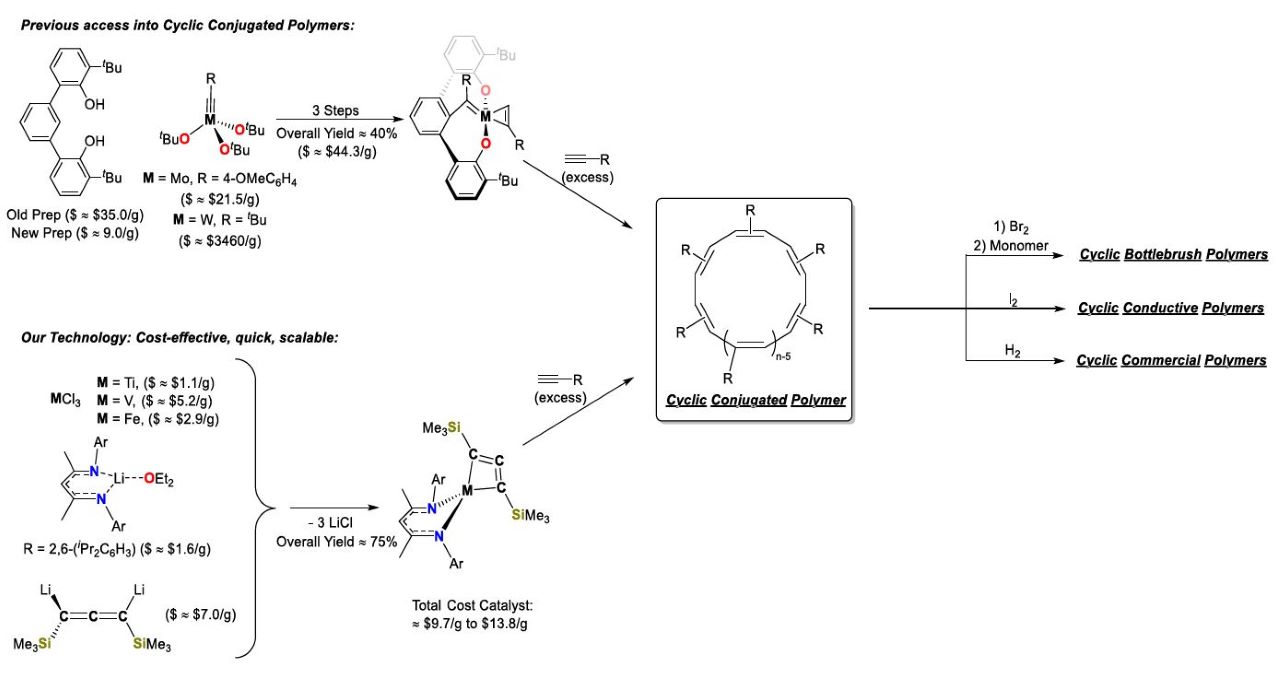A class of base metal catalysts (as opposed to expensive platinum and heavier group metals) with facile preparation methods for cyclic conjugated polymer synthesis.
Problem:
There is a demand for facile synthesis and purification of cyclic conjugated polymers due to their applications as lubricants, conductors, or materials with high refractive indices. Current methods for cyclic polymerization make use of catalysts with lengthy synthetic techniques and costly purification requirements. Additionally, the metals used in these catalysts, such as Rhodium (Rh), Molybdenum (Mo), and Tungsten (W), are expensive, limiting their commercial potential and rely on imports from countries around the globe (China (top producer), Vietnam, Russia, Bolivia and Rwanda), which puts a large demand on a volatile supply chain.
Solution:
A class of catalysts that can be synthesized in two steps using base metals, rather than expensive platinum group and heavier metals. This type of catalyst is less expensive and easier to make compared to current technologies, and can be made in gram-quantities, allowing for facile scale-up.
Technology:
A catalyst consisting of an allene dianion ligand, [Me3SiCCCSiMe3]2- and a base metal, such as Ti (Titanium), V (Vanadium), or Fe (Iron). Once synthesized, the catalysts perform polymerization catalysis on alkyne substrates, which form rings with no beginning or ending functional groups unlike linear polymers. By addressing the need for synthetic routes capable of large-batch production of catalysts, the catalyst addresses a longstanding need for the development of industrial cyclic conjugated polymer materials. Furthermore, these cyclic conjugated polymers can be further functionalized with existing technologies to make bottlebrush polymers, conductive polymers, and unsaturated polymers that resemble commercial polymers.
Advantages:
- Use of base metals Ti, V, and Fe are less expensive than the traditional metals used for cyclic polymerization catalysts such as Rh, Mo, and W.
- Two-step ligand synthesis followed by single-step metalation provides an easy, inexpensive synthetic route for a cyclic polymerization catalyst compared to traditional catalysts.
- Gram-scale production of the catalyst indicates that scale-up for industrial use is feasible.
- Metal identity is shown to be variable, allowing for flexibility in synthetic route and scale-up compared to traditional cyclic polymerization catalysts.

Previous technology to access cyclic conjugated polymers (top). Our recent technology into cyclic conjugated polymers (bottom). Cost analysis approximated based on cost of chemicals from our strategic suppliers at the University of Pennsylvania in January of 2024.
Stage of Development:
- Proof of Concept
- Bench Prototype
Intellectual Property:
- PCT Filed
- US Patent Pending
Case ID:
23-10298-tpNCS
Web Published:
1/29/2024
Patent Information:
| App Type |
Country |
Serial No. |
Patent No. |
File Date |
Issued Date |
Expire Date |